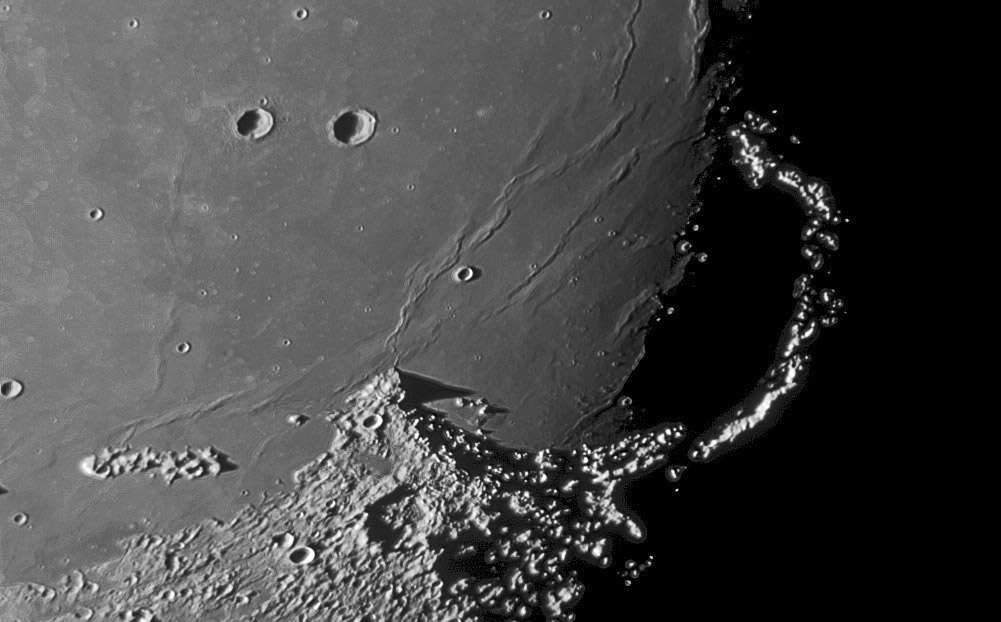Difference between revisions of "May 7, 2011"
| Line 3: | Line 3: | ||
<!-- ws:start:WikiTextHeadingRule:0:<h1> --> | <!-- ws:start:WikiTextHeadingRule:0:<h1> --> | ||
<!-- ws:start:WikiTextLocalImageRule:6:<img src="/file/view/LPOD-May7-11.jpg/226303382/LPOD-May7-11.jpg" alt="" title="" /> -->[[File:LPOD-May7-11.jpg|LPOD-May7-11.jpg]]<!-- ws:end:WikiTextLocalImageRule:6 --><br /> | <!-- ws:start:WikiTextLocalImageRule:6:<img src="/file/view/LPOD-May7-11.jpg/226303382/LPOD-May7-11.jpg" alt="" title="" /> -->[[File:LPOD-May7-11.jpg|LPOD-May7-11.jpg]]<!-- ws:end:WikiTextLocalImageRule:6 --><br /> | ||
| − | <em>south up image by [mailto:yukichankkk@yahoo.co.jp | + | <em>south up image by [mailto:yukichankkk@yahoo.co.jp Morio Higashida], Osaka,Japan</em><br /> |
<br /> | <br /> | ||
Sinus Iridum and its surrounding half-crater rim, the Jura Mountains, is a favorite of probably every lunar observer. <br /> | Sinus Iridum and its surrounding half-crater rim, the Jura Mountains, is a favorite of probably every lunar observer. <br /> | ||
| Line 17: | Line 17: | ||
rim of the ancient Jura crater.<br /> | rim of the ancient Jura crater.<br /> | ||
<br /> | <br /> | ||
| − | <em>[mailto:tychocrater@yahoo.com | + | <em>[mailto:tychocrater@yahoo.com Chuck Wood]</em><br /> |
<br /> | <br /> | ||
<strong>Technical Details</strong><br /> | <strong>Technical Details</strong><br /> | ||
| Line 24: | Line 24: | ||
<strong>Related Links</strong><br /> | <strong>Related Links</strong><br /> | ||
Rükl plate [http://the-moon.wikispaces.com/R%C3%BCkl+10 10]<br /> | Rükl plate [http://the-moon.wikispaces.com/R%C3%BCkl+10 10]<br /> | ||
| − | Morio's [http://mo.atz.jp/ | + | Morio's [http://mo.atz.jp/ website]<br /> |
<br /> | <br /> | ||
<hr /> | <hr /> | ||
Revision as of 17:34, 11 January 2015
Great Rainbow

south up image by Morio Higashida, Osaka,Japan
Sinus Iridum and its surrounding half-crater rim, the Jura Mountains, is a favorite of probably every lunar observer.
The mountains always seem to catch the light, and in the best of illuminations as Morio captured, the curved ridge
is speckles of brightness with darkness on either side. Having the terminator pass through the floor of the sinus is
uncommon, and here each small crater stands out as a fat ring of light. The low lighting also emphasizes the mare
ridges. There seem to be two families of intersecting ridges - most are about parallel to the shore of Mare Imbrium.
The longest of these ridges starts near the Straight Range and widens as it passes Prom. Laplace and continues
across Iridum. Shorter ridges closer to the Jura are about parallel. This family of mare ridges gives the impression
of waves lapping onto the shore. The second family of ridges is really just one that seems to continue the curve of
the crater rim out past Prom Laplace. It crosses the broader ocean wave ridge, and doesn't really bend to connect
back to Prom. Heraclides to the west, but an overhead view shows that it is the right place to mark the vanquished
rim of the ancient Jura crater.
Chuck Wood
Technical Details
13 Apr.2011. 11h 05m 53s (UT). Takahashi Mewlon250 + DMK31AU03
Related Links
Rükl plate 10
Morio's website



